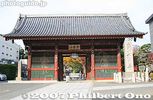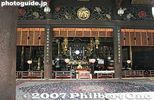 Image search results - "bunkyo-ku" Image search results - "bunkyo-ku" |

Belonging to the Buzan School of the Shingon Sect of Buddhism, Gokokuji Temple was built by the mother of Shogun Tokugawa Tsunayoshi in 1682. The Gekkoden Hall was moved here from Miidera temple in Otsu, Shiga Pref. The Tahoto Pagoda was modeled after the Tahoto at Ishiyamadera in Otsu, Shiga. Okuma Shigenobu, founder of Waseda Univ., is also buried here. This is the entrance to Gokokuji Temple, Niomon Gate. It's right next to Gokokuji Station on the Yurakucho subway line. 仁王門
|
|

After you pass through the Niomon Gate, this is what you see.
|
|

Well
|
|

Well
|
|

Map of temple grounds. Belonging to the Buzan School of the Shingon Sect of Buddhism, Gokokuji temple was built by the mother of Shogun Tokugawa Tsunayoshi in 1682.
|
|

Steps going up to an inner gate called Furomon 不老門
|
|

Furomon Gate (Ageless Gate) 不老門
|
|

View from Furomon Gate
|
|
|
|
|
|

Nezu Station (Chiyoda Line) platform. Just follow the sign to get out the correct exit. 根津駅
|
|

Buddha statue with Tahoto Pagoda in background
|
|

On the street, just follow the signs to Nezu Shrine. Only a few minutes walk.
|
|

Kannon-do main worship hall 観音堂(本堂)Gokokuji Temple has held large funerals for some famous people like singer Yutaka Ozaki in 1992.
|
|

Nezu Shrine torii gate 根津神社
|
|

Kannon-do main worship hall 観音堂(本堂)
|
|

Nezu Shrine torii gate 根津神社
|
|

Daibutsu Buddha statue
|
|

The Bunkyo Tsutsuji Matsuri or Azalea Festival is held from April to early May at Nezu Shrine which has a slope filled with 50 varieties of azaleas.
|
|

Daibutsu Buddha statue
|
|

Azalea Garden and Nezu Shrine gate 楼門(国指定重文)
|
|

Tahoto Pagoda at Gokokuji temple in Bunkyo, Tokyo. Built in 1938 modeled after the original Tahoto Pagoda at Ishiyama-dera temple in Otsu, Shiga Prefecture. 多宝塔
|
|

The azaleas usually reach full bloom in late April, but there are flowers which bloom later or earlier so there's always something in bloom during the festival period.
|
|
|
|
|
|

This bridge was recently rebuilt.
|
|
|
|

The large slope of azalea bushes have walking paths where you can see and photograph the flowers up close.
|
|
|

Nezu Shrine, Tokyo
|
|

Entrance to Koishikawa Korakuen Garden. It opened as a public garden in 1938. The garden is modeled after Chinese concepts and features.Near Iiidabashi Station and Korakuen Station.
|
|
|

Some bushes are in full bloom, while others are still too early.
|
|

Ticket office at Koishikawa Korakuen Garden. Admission ¥300. Free English pamphlet/map available.
|
|

Tahoto Pagoda and Gekkoden Hall at Gokokuji temple in Bunkyo-ku, Tokyo
|
|
|

Map of garden. Koishikawa Korakuen Garden is designated as one of Japan's Special Historic Place and Special Scenic Spot. Only select places in Japan (like Kyoto's Kinkakuji) have both designations. 国の特別史跡・特別名勝
|
|

Gekkoden Hall (Important Cultural Property). It was moved here from Miidera temple in Otsu, Shiga Prefecture. Now it serves as a tea ceremony headquarters 茶道本山. 月光殿
|
|

Entry to the azalea garden. 200 yen admission (actually a donation). Open 9am to 5 pm.
|
|

Weeping cherry tree
|
|

Kannon-do main worship hall and autumn leaves
|
|

Walking path among the azaleas.
|
|

Weeping cherry tree, Koishikawa Korakuen Garden, Tokyo. 枝垂桜
|
|

Kannon-do main worship hall and autumn leaves
|
|
|

This weeping cherry tree is about 60 years old.
|
|

Side of Kannon-do main worship hall and autumn leaves
|
|

Shrine gate and azaleas.
|
|

Weeping cherry tree, Koishikawa Korakuen Garden, Tokyo.
|
|
|
|
|

Weeping cherry tree, Koishikawa Korakuen Garden, Tokyo. Called "Shidare-sakura" in Japanese meaning cherry tree with drooping branches.
|
|
|
|

With Tokyo Dome looming above, Koishikawa Korakuen is another famous Edo-Period Japanese garden originally built by Lord Yorifusa of the Mito Tokugawa Clan in 1629 as part of his Edo estate.The garden was completed under Lord Mitsukuni, the second lord of the Mito clan.
|
|

Rear of Kannon-do main worship hall and autumn leaves
|
|

This variety of azaleas are the most common in Japan.
|
|
|
|
|
|
|
|
|
|

Shorozan hill 小廬山
|
|

Corner of railing on Kannon-do
|
|
|
|
|

Kannon-do
|
|
|

Tokyo Dome in the background. The garden is right next to Tokyo Dome.
|
|

Kannon-do
|
|

Many exotic varieties of azaleas.
|
|
|

Kannon-do
|
|

Mixed colors
|
|

Larger weeping cherry tree.
|
|

Inside Kannon-do main hall
|
|

Dainty ones
|
|
|
|
|

Flower crush
|
|
|
|
|

Great view for lunch.
|
|

Weeping cherry tree, Koishikawa Korakuen Garden, Tokyo.
|
|
|
|
|

Weeping cherries
|
|

Grave of Okuma Shigenobu, former Prime Minister and founder of Waseda University.
|
|
|

Weeping cherry tree and Tsutenkyo Bridge 通天橋
|
|

Grave of Okuma Shigenobu
|
|
|

Tsutenkyo Bridge 通天橋
|
|

Another grand grave
|
|
|

Large weeping cherry tree しだれ桜
|
|

Cemetary behind the temple
|
|
|
|
|
|
|

Folding screen (byobu) rock 屏風岩
|
|
|

Guess who was there too? Nobuyoshi Araki, Japan's most famous photographer shooting the azaleas at Nezu Shrine, Tokyo. That's a Canon EOS 7 film camera.
|
|

Tsutenkyo Bridge 通天橋
|
|
|
|

Top of the slope.
|
|

View from Tsutenkyo Bridge 通天橋
|
|

Gingko tree in fall
|
|

Quite spectacular from the top. Nezu Shrine.
|
|
|
|
|

Tokujindo Hall which stores wooden statues from old Chinese stories. 得仁堂
|
|
|
|

Koishikawa Korakuen Garden has a circular design around a pond and low hill. 回遊式庭園
|
|

Yakushido Hall 薬師堂
|
|
|

Picnic area
|
|

33rd temple on the Saigoku Pilgrimage circuit
|
|
|
|
|
|
|

Cherry trees line the Osensui pond. 大泉水
|
|

Bell tower 鐘楼(付梵鐘)
|
|
|

In the background is Horaijima island (not accessible). 蓬莱島
|
|

Stone lanterns
|
|

Azaleas and torii gates, Nezu Shrine
|
|

Shiraito Waterfall. Nothing spectacular. 白糸の滝
|
|
|
|
|

Iris bed. Should come back in June.
|
|

Tea ceremony women
|
|

Buds to bloom
|
|

Colorful flowers break the monotony of greenery. ハナモモ
|
|
|

White and pink mixed together.
|
|

Ornamental peaches (Hanamomo in Japanese) ハナモモ
|
|

Mt. Fuji motif
|
|
|

White ornamental peaches (Hanamomo in Japanese) look like cotton on branches. ハナモモ
|
|
|
|
|

White ornamental peaches ハナモモ
|
|
|
|

Song monument
|
|
|
|

This little hill was spectacular.
|
|
|
|
|

All these reds and pinks drove my eyes crazy.
|
|
|
|
|

They cannot bloom any better than this.
|
|
|
|

The White One
|
|
|

Azaleas and torii gates
|
|

Azaleas and torii gates
|
|
|
|
|
|

This was a weekday so it is less crowded than the weekend.
|
|
|
|
|

How do they mix these flower colors?
|
|

More flower blobs...
|
|
|
|

Azalea Ball
|
|

Can you believe yellow azaleas??
|
|

Great relief for the eyes after seeing so much red and pink. Yellow azaleas.
|
|
|
|
|
|
|
|
|
|

Splotch of pink on white
|
|
|
|
|

Eight-plank Bridge 八つ橋
|
|
|

Engetsukyo Bridge (Full Moon Bridge) 円月橋
|
|
|
|

Stone bridge steps 円月橋
|
|
|

Engetsukyo Bridge (Full Moon Bridge) so named because it creates full moon with its reflection in the water. 円月橋
|
|
|
|

Kuhachi-ya 九八屋
|
|

Wish they also wrote the name in English... ハナグルマ
|
|

Naitei Inner Garden, formerly a private garden for a guesthouse built by the Mito Clan. The garden just does not match the huge Tokyo Dome in the background... 内庭
|
|
|
|

Picnickers
|
|
|

Outside wall of garden.
|
|

Torii gates and azaleas
|
|

The outside wall also uses stones from the Sotobori Moat of Edo Castle.
|
|

Torii gates and azaleas
|
|

Nezu Shrine bridge (built in 2006 神橋) and gate, Important Cultural Property 楼門(国指定重文)
|
|

Nezu Shrine gate, Important Cultural Property 楼門(国指定重文)
|
|
|

Nezu Shrine
|
|

Nezu Shrine Kaguraden
|
|

Nezu Shrine Karamon Gate, Important Cultural Property. Nezu Shrine is dedicated to Susano-o-no-Mikoto, younger brother of Sun Goddess Amaterasu. 唐門
|
|

Nezu Shrine Karamon Gate, Important Cultural Property 唐門
|
|

Nezu Shrine Haiden Hall, Important Cultural Property 拝殿
|
|

Ema votive tablets
|
|

Torii gates (all donated by people)
|
|

Torii gates
|
|

Way to Hakusan Shrine in Bunkyo Ward, Tokyo, near Hakusan Station on the Toei Mita Line and Hon-Magome Station on the Nanboku Line.
|
|

Approaching Hakusan Shrine, site of the annual Bunkyo Ajisai Matsuri held during June 6-14, 2009. Ajisai means hydrangea, a flower which blooms during the rainy season.
|
|

Hakusan Jinja Shrine torii.
|
|

Dubbed Mt. Fuji, this pile of colorful hydrangea is stacked like a mountain. Capped by white flowers for snow. Hakusan Shrine in Bunkyo, Tokyo
|
|

Hydrangeas in the shape of Mt. Fuji.
|
|

Hakusan Shrine in Bunkyo, Tokyo
|
|

Red, white, and blue ajisai.
|
|

During the festival, a few concerts, bazaar, etc., are held.
|
|
|
|

It's not a huge shrine, but the many hydrangeas make it worth a visit.
|
|
|

Path to the Honden worship hall.
|
|

Praying at Hakusan Shrine's Honden Hall, flanked by lion dogs decorated with hydrangea.
|
|

Lion dog with hydrangea.
|
|

Ajisai or hydrangea need water. They can wither on sunny days.
|
|
|
|

Information booth
|
|

Food stalls
|
|

Entrance to a small hill of ajisai where there is a tiny shrine at the top.
|
|
|
|
|
|

Top of the hill has Asama Jinja 浅間神社.
|
|

View from the hill.
|
|
|
|
|
|
|
|
|
|

This path connects the shrine to the adjacent Hakusan Park.
|
|

Hakusan Park has more ajisai. 白山公園
|
|
| 861 files on 4 page(s) |
1 |
 |
|